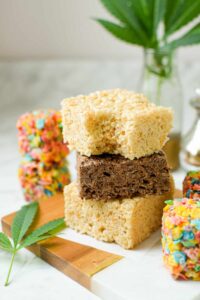One of the most familiar ways to make homemade edibles is infused cannabis butter. It’s versatile and can be used in many edible recipes, yet how to make cannabutter at home is a relatively easy process.
Keep in mind that you will have to heat the herb slowly, so it’s essential to pay attention during every step of the process. Below, we guide you through all the steps, from decarboxylation to a fully cannabis-infused product.
What is Cannabis Butter?
Cannabutter is unsalted butter infused with cannabis and is an essential ingredient in many delicious weed edibles. It’s just one of the numerous ways to consume marijuana, but definitely among the most popular. There are dozens of dishes that use cannabis as an ingredient, including desserts, pasta, soups, and more.
Weed brownies and many other homemade edibles typically use a cannabutter replacement for unsalted butter. This is a tasty way to receive the high that comes along with adding THC to your food. Especially for those that don’t enjoy smoking marijuana, cannabis butter is just as effective for enjoying the benefits of cannabis without the smoke.
There’s no need to be a top chef or highly knowledgeable about cannabis to whip up a cannabutter recipe. When utilizing cannabutter, there are endless possibilities for substitution. Really, with any recipe that calls for butter, olive oil, coconut oil, etc., cannabis-infused butter can be used as a replacement.
Human civilizations have been making homemade cannabis edibles for centuries, beginning with the invention of bhang. Bhang is prepared from the buds of a cannabis plant and then typically consumed as a beverage among parts of South Asia. It’s a combination of milk, spices, and ghee crafted to infuse food and drinks with cannabis for medicinal benefits.
Here is one of our favorite bhang recipes for those interested in attempting to make it at home:
Indian Bhang Recipe
Ingredients
- 1/8 ounce of unsalted butter
- 2 cups whole milk
- 1 or 2 grams of herb
- pinch of cinnamon or nutmeg (depending on preference)
Directions
- Melt butter in a saucepan
- Add ground cannabis flower
- Simmer for 1 min, add milk
- Gently warm, then add spices
- Drink as a beverage or use in a food recipe
What are the Benefits of Cannabis?
Below, we have listed the top fifteen medicinal benefits of CBD and THC. Depending on local laws, we recommend speaking with your doctor or local dispensary expert to find out the right strain for you.
- blood pressure regulation
- stress relief and muscle relaxant
- depression and anxiety control
- reducing inflammation
- fighting cancer and its symptoms
- can help with alcohol and hard drug addiction
- anti-convulsion/ anti-seizure, tremor relief
- gastrointestinal disorders
- appetite and weight management
- can improve lung capacity
- neuroprotectant
- PTSD management
- autism treatment
- ADD/ADHD treatment
- chronic pain relief
- fibromyalgia
- glaucoma
- arthritis
- multiple sclerosis
- endometriosis
Is it Cheaper to Buy or Make cannabutter?
There are high-quality cannabis infusions available for purchase online or in stores, but they will be fairly pricey. We found the average price for cannabutter online is forty dollars for four ounces of product.
To make the cannabutter, you’re looking at a few hours of fairly easy labor and about fifty dollars in cost for double the amount of product. So, depending on how much time and space you have to cook, making your own is a much more affordable option.
Can You Make Cannabis Butter Quickly?
Extracting THC from finely crushed cannabis flowers takes around two to three hours. Then, you’ll want to simmer it for another two to three hours and let it sit in the refrigerator overnight. It is reasonable to assume you can begin the process one day and have a fully infused, potent butter or oil.
How Long Does it Take for Homemade Cannabutter to Kick in?
It usually takes 30–90 minutes to feel the full effects of edible foods. Reaction times can typically last two to four hours; however, this depends on dosage, tolerance level, body weight, and metabolism.
Mistakes to Avoid When Making Weed Butter
Decarb before adding ground cannabis flower. If you don’t, the butter will not taste great, and it will be less potent due to cannabinoids not being fully activated. Just be sure to use the right amount of heat to decarb cannabis, not too much heat, not too little.
Get the grind just right. If you grind the weed too fine, you’ll end up with a green, odd-tasting butter or oil. It’s best to use a hand grinder or coarse coffee grinder for optimum results.
Be patient when straining the oil. A cheesecloth, gravity, and time are the three ingredients needed to strain your infused butter properly. Do not squeeze the cloth at the risk of adding in excess plant matter.
Mix the batch well. Remember to occasionally stir when making cannabutter and mix well towards the end for an even level of potency and flavor.
Why You’ll Love This Recipe
Cannabis butter, also known as cannabutter, is one of the most cherished cannabis recipes of the food-cannabis industry. The below recipe for how to make cannabutter is simple, effective, and easy to follow.
Once you have your first batch of cannabis infusion, you’ll find ways to incorporate your own cannabutter into your favorite recipe time and time again.
The Step-By-Step Process for How to Make Cannabutter
Here, we provide a detailed guide with all the steps for how to make cannabutter. This article will provide essential details and a simple, step-by-step recipe that’s easy to print or save for later.
Use High-Quality Cannabis Flowers
The quality of your cannabis flower is essential. It can affect the potency and flavor of your finished weed oil. It’s crucial to find a high-quality strain with the desired effects you’re looking to feel.
Pairing potent, decarbed cannabis with good quality butter is an excellent way to ensure that you have the best cannabutter possible.
Preheat Your Flower
In raw form, marijuana has no psychoactive potential. Natural cannabis and its derivatives contain cannabinoids THCA and CBDA. When you eliminate A, you’ll find THC and CBD. Without activation, this drug does not cause any psychoactive effects.
To make THC and CBDA, heat and time are necessary ingredients. The greater the temperature, the quicker the reaction is. If used as cannabutter, excessive heating produces a taste similar to burnt popcorn. There are many options for decarboxylating weed.
So, what is the best method?
Decide on a Decarb Process
As previously discussed, the cannabis leaf is organically non-psychedelic. This plant material contains high amounts of cannabinoids such as THCAs and CBDA, which form a broad range of cannabinoid acids. To achieve the ‘high’ effect of marijuana, you will have to convert the cannabis through decarboxylation.
Cannabutter is primarily made by decarboxylating cannabis flowers and can be made using various techniques for the infusion process. The cannabinoids that live within cannabis flowers are activated when they are decarboxylated or removed.
From your experience, you may have thought weed would be potent without this step. Although you can eat a small portion of dried cannabis flowers that can definitely affect your body, it’s not as effective as smoking. These cannabinoid compounds need heat to transform, which is called decarboxylation.
Baking
If you’re planning to make infused butter with cannabis flower, baking your weed first is an optimal way to decarb. You’ll want to break up your buds into small pieces and evenly distribute them on a sheet pan with parchment paper.
Then, you’ll cover and bake on low heat for thirty minutes. After it cools, you’ll have fully decarbed cannabis to use for your own edibles.
Boiling
You can also boil cannabis in a tea bag or place it in a heatproof bowl of simmering water to draw out the cannabinoids. Once the cannabis has reached the ideal temperature, you can then add in melted butter to provide something the cannabinoids can stick to.
Pick Your Fat or Butter
Regular butter is a type of fat used in a cooking experiment for cannabis and has an ideal consistency and flavor and should be included in many baking recipes. Based on how you plan on using this fat, you could add some additional ingredients.
Olive oil, vegetable oil, coconut oil — all fatty acids that can remain stable in the liquid between 160-200 degrees can be used to infuse butter. The milk solids will dissolve during the process.
Steep Away
It is possible to soak decarbed grass with fat by following several techniques. The best option depends upon your taste and what equipment you have to work with. Probably the most basic version occurs over the stove using one or two large pots.
The first way you could make a batch of cannabutter is to mix the butter in equal parts of water. The process aims to keep the temperature within 160 to 220 degrees, so be proactive in piloting your newly brewed beer from the start to the end.
Once you have decarbed the weed, you can also place the butter mixture in the microwave to infuse it. Mix two cups of water with the butter, and it will heat fast and evenly while eliminating excess water and milk solids. The butter should cook at around 300 degrees Fahrenheit. Cooking thermometers are useful for measuring temperature accurately.
Strain the Butter
After simmering and slowly increasing the butter’s temperature, you need to strain it. Put a few layers of cheesecloth into jars and utilize an elastic band to keep it safe during tension. You can do the same process with a coffee filter if you don’t have access to a cheesecloth.
Pour a small amount of butter into a cheesecloth and allow ample time for drainage and evaporation of milk solids to prevent overflow. When strained, it can easily be removed or recycled into compost, and the butter can go into a mason jar. Then, placing in a mason jar for a few hours in the refrigerator will complete the process.
It can be used immediately to make baked goods and many recipes involving cannabis. Infused butter and fats last up to six months in the refrigerator and up to a year in the freezer when appropriately stored in mason jars or other sealed glass containers.
Alternative Cooking Method to Make Cannabutter
All three methods below aim at maintaining equilibrium in butter temperature to prevent heat or burn.
How to Make Cannabutter in a Crock-Pot
If you’re looking for a different method to make cannabutter, you can also decarb weed using a slow cooker and olive or coconut oil instead of butter. You’ll place dried cannabis and your chosen oil into the slow cooker for this recipe.
How much cannabis will depend on the amount of butter you want at once. Then, cover and cook on high for an hour. Turn the slow cooker down and cook on low for another three hours, and strain the cooled butter as usual.
Sous Vide Canna Butter
The method for sous vide cannabutter is an excellent choice for those wanting to release as slight an odor as possible. If you live in an apartment complex with your parents or just want to discreetly, this method will work for you.
With the sous vide method, you’ll still begin by coarsely grinding the plant matter with a hand or coffee grinder and placing them in a heat-proof, vacuum-sealed bag. After that, place a large pot on the stovetop and fill it with water.
Once the water has reached 230 Fahrenheit degrees, place your sealed bag of buds in hot water and cook for an hour and a half before infusing the butter.
Using the Double Boiler for Cannabis Butter
First, for the double boiler method, you’ll fill the lower half with water and melt the butter in the top half above your hot water pan. Then, add a cup of water to regulate the temperature at low heat. Once thoroughly mixed, add your cannabis, simmer and stir occasionally to ensure your butter doesn’t overheat.
How to Dose Your Weed Butter
Back when edibles were getting their start, cannabis users weren’t necessarily keen on the potency of the cannabutter recipe used. The cannabis education and tools just weren’t out there yet. But, they are now. Today’s cannabis consumers are more familiar with personal usage and dosage thanks to the introduction of retail-regulated edible products.
Proper dosage of cannabis butter can be tricky as many variables are involved. The best idea for beginner use is always to consume less than you believe you’ll need. For your first batch, start low and move up in increments from there, depending on your desired effects. Don’t consume more butter right away without knowing its relative power and your tolerance. No matter what, wait about 1 to 2 days to increase the dosage after your first experience.
The quantity of cannabis differs depending upon the strain, recipe, and technique you use. What you want to know is THCA percent. The THCA is measurable on most legal marijuana jars, so it should be easily found. The below site provides an approximation equation that helps to calculate doses. It gives a reasonable estimation of how much butter you’ll use and can be used as a guideline for dosage. Remember, many variables determine the amount of THC you are consuming.
Edible Butter Dosage Calculations
If you’d like to learn the math behind making cannabutter, please follow this guide. Using this handy THC calculator, you can make maths easier for you:
How to Store Weed Butter or Oil
Once the cannabutter has been activated, the shelf-life will be up to six months, depending on the quality of regular butter used. You will lose other cannabinoids in that time, and the relative potency will decrease with time. So, it’s best to use it as quickly as possible within reason. Frozen cannabutter can last much longer.
Store cannabutter in a sealed container inside the refrigerator. Filling mason jars is useful. It can also be stored in opaque glasses and opaque containers. In addition to decarbing cannabis, light exposure can decrease the lasting effects.
Always taste older cannabis butter before using it. Don’t use it if it seems rancid or has an off-putting smell.
What Is the Connection Between Frenchy Cannoli and Making Cannabutter?
Frenchy Cannoli, a legendary hashishin, revolutionized the cannabis industry with his expertise in making cannabutter. Known for his dedication to preserving the traditional methods of hash-making, Frenchy Cannoli‘s techniques have greatly influenced the art of producing high-quality cannabutter, creating a lasting impact on the life of Frenchy Cannoli.
Cooking With Cannabis butter
Cooking cannabis has become a huge trend among restaurant entrepreneurs, chefs, and those in the recipe and food styling business.
The Food Innovation Group, including top brands such as Bon Appetit and Epicurious, has featured many cannabis dishes, chefs, and restaurants in the past few years. As legal access grows, the cannabis food industry will become more relevant than ever.
Here, we’ll share our favorite sweet and savory recipes to use with cannabis butter, sure to make your entire dish fun and delicious from start to finish. There are so many recipes to choose from, be sure to search online if you’re feeling creative.

Keep in Mind
Whichever method you decide on, knowing how to make cannabis butter is a valuable tool for those that want to benefit from the medicinal qualities of weed without always having to light up.
Make sure to be present and prepared throughout the entire process, follow the instructions for your chosen method, and you’ll be well on your way to making tasty canna butter treats.
Get Your Medical Card
Connect with a licensed physician online in minutes












